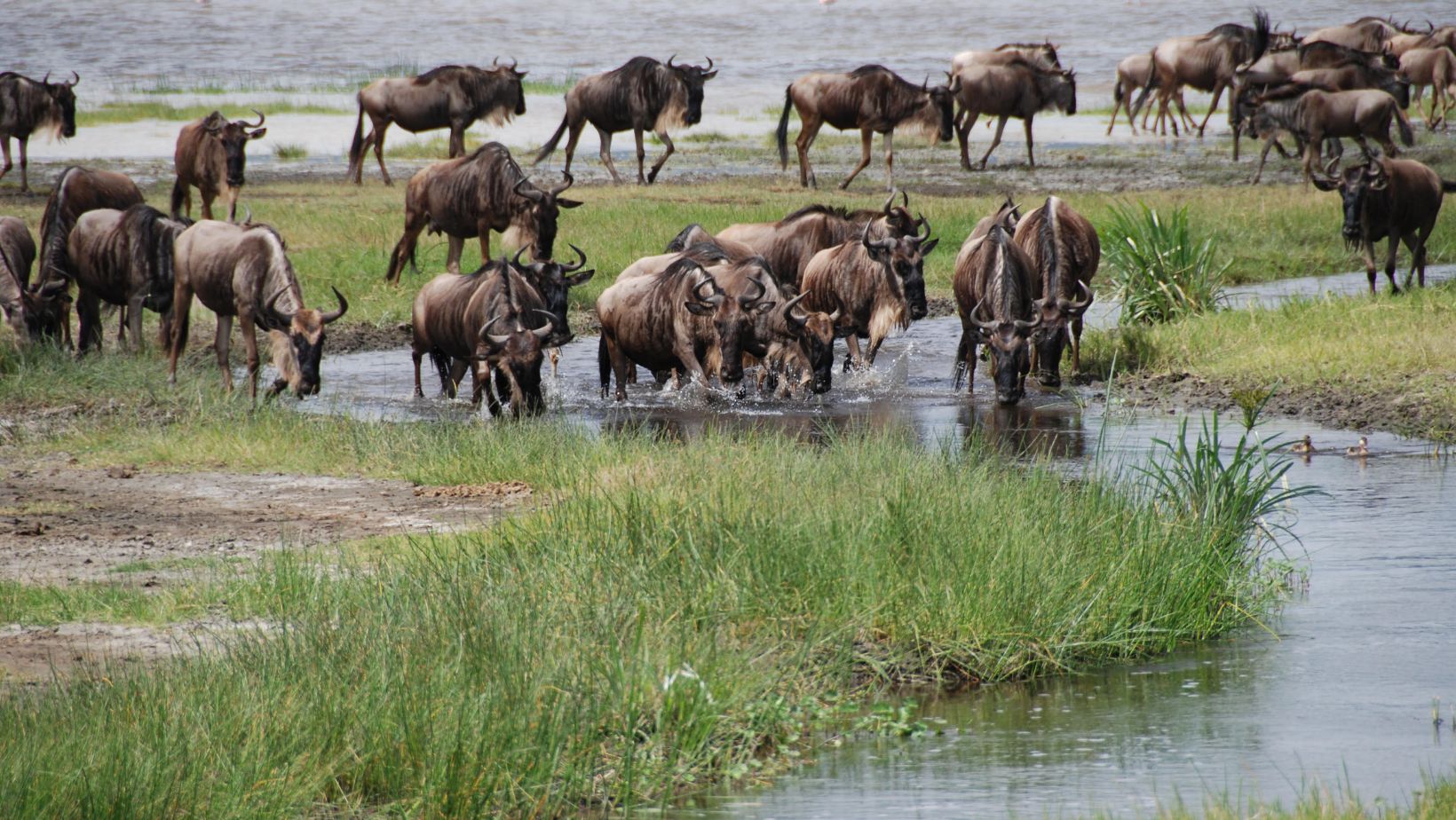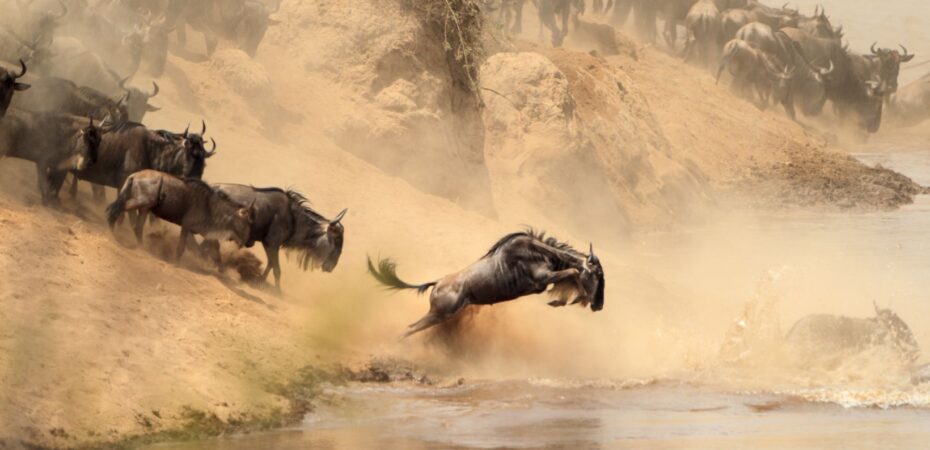The Great Migration stands as one of Earth’s most extraordinary natural phenomena, where over 1.5 million wildebeest embark on an epic journey across the Serengeti-Mara ecosystem. This incredible spectacle involves not just wildebeest, but hundreds of thousands of zebras, gazelles, and other antelope species following ancient routes in search of fresh grazing and water. The sheer scale of this movement creates what can only be described as “the greatest show on Earth,” with columns of animals so vast they can be seen from space.
What is the Wildebeest Migration?
The wildebeest migration represents the largest herd movement of animals on our planet. This isn’t just a simple journey from point A to point B – it’s a continuous, year-round circular migration that follows the rhythm of East Africa’s rainfall patterns. When you witness this spectacle firsthand, you’ll understand why it captivates wildlife enthusiasts from around the globe.
The numbers are truly staggering. Over 1.2 million wildebeest and 300,000 zebra participate in this annual cycle, joined by Thomson’s gazelles, elands, and topi. Each individual wildebeest covers between 800 to 1,000 kilometers on its personal journey, guided purely by survival instinct.
The Animals Involved in the Great Migration
- Wildebeest: The main stars of the show, these gnu follow age-old migration routes.
- Zebras: Acting as guides with excellent eyesight and memory for safe routes.
- Thomson’s gazelles: Swift antelope that join the massive herds.
- Elands: Africa’s largest antelope species participating in the movement.
- Predators: Lions, leopards, cheetahs, hyenas, and crocodiles that follow the herds.
The relationship between zebras and wildebeest during the migration is particularly fascinating. Zebras use their superior eyesight to scan for threats, while wildebeest rely on their keen sense of smell and hearing. This symbiotic partnership has evolved over millennia, creating one of nature’s most effective survival strategies.
Where Does the Wildebeest Migration Take Place?
The Serengeti wildebeest migration and Maasai Mara wildebeest migration occur within a 40,000-square mile area known as the Serengeti ecosystem. This vast landscape spans two countries and includes some of Africa’s most iconic wildlife destinations.
Key Locations for the Wildebeest Migration
Tanzania:
- Serengeti National Park: The heart of the migration route.
- Ngorongoro Conservation Area: Critical calving grounds in the south.
- Western Corridor: Important crossing point along the Grumeti River.
- Northern Serengeti: Gateway to Kenya’s Maasai Mara.
Kenya:
- Maasai Mara National Reserve: Famous for dramatic river crossings.
- Masai Mara ecosystem: Where the herds spend July through October.
 The Serengeti ecosystem encompasses not just the famous national parks, but also conservancies, game reserves, and community lands that form crucial corridors for animal movement. Understanding this broader ecosystem helps explain why conservation efforts must extend beyond park boundaries.
The Serengeti ecosystem encompasses not just the famous national parks, but also conservancies, game reserves, and community lands that form crucial corridors for animal movement. Understanding this broader ecosystem helps explain why conservation efforts must extend beyond park boundaries.
When is the Wildebeest Migration? A Monthly Breakdown
Many people ask, “What is the best month to see the wildebeest migration?” The truth is, this phenomenon occurs year-round, but different locations offer unique experiences depending on the season.
January Wildebeest Migration
The year begins with anticipation in the southern Serengeti and Ndutu plains. Pregnant females gather on the short-grass plains, preparing for the upcoming calving season. January temperatures reach an average high of 28°C (82°F), making it an excellent time for wildlife viewing as animals concentrate around water sources.
February Wildebeest Migration: Calving Season
February marks the peak of the wildebeest calving season, one of nature’s most incredible synchronized events. During this period, approximately 500,000 wildebeest calves are born within just a few weeks, with over 8,000 calves potentially born in a single day. This strategy floods the area with newborns, reducing the chances of any individual calf being taken by predators.
March Wildebeest Migration
The herds continue spreading across the southern Serengeti, with mothers nursing their young and preparing for the northward journey. This period offers excellent opportunities to witness predator action during calving season as lions, cheetahs, and hyenas take advantage of the abundance of young prey.
April-May: Beginning the Northern Journey
As the dry season approaches, the annual wildebeest migration cycle shifts into high gear. Herds begin their northward migration through the central Serengeti, moving through the Moru Kopjes and Seronera areas. The Western Corridor migration becomes particularly active as animals head toward the Grumeti River.
June: Massing for River Crossings
The herds mass in the western corridor, bunching together before attempting to cross the Grumeti River. This period builds anticipation for the dramatic Grumeti River crossing events that captivate safari-goers.
July Wildebeest Migration: Enter the Maasai Mara
July typically marks the beginning of the most famous phase – the entry into Kenya’s Maasai Mara. This is when many travelers plan their wildebeest migration safari to witness the iconic Mara River crossing events.
August Wildebeest Migration: Peak Drama
August delivers peak drama as massive herds attempt the treacherous Mara River crossings. The sight of thousands of animals plunging into crocodile-infested waters while predators wait on both sides creates some of wildlife photography’s most iconic moments.
September-October Wildebeest Migration
The herds spend these months in the northern Serengeti and Maasai Mara, gradually beginning their southward migration back to Tanzania. October often sees the return journey, with animals crossing back into the Serengeti.
November-December: Completing the Circle
The migration completes its circle as herds move south through Loliondo on the eastern side of the Serengeti, arriving back on the short-grass plains in time for the rains and the next calving season.
Why Does the Wildebeest Migration Happen?
Understanding why this epic journey occurs helps us appreciate its crucial role in the African wildlife migration ecosystem. The migration is fundamentally driven by the search for fresh grazing and water, following East Africa’s seasonal rainfall patterns.
Primary Drivers of Migration
Rainfall Patterns:
Animals migrate because of rain – or the lack of it. When seasonal drought dries up grass and water supplies in one area, the grazing animals move to regions where seasonal rains are falling.
Nutritional Needs:
The volcanic soils of the southern Serengeti provide the most nutritious grass, essential for pregnant females and nursing mothers. This explains why the calving season consistently occurs in this region.
Survival Instinct:
Each animal is guided by an ancient survival instinct, following routes established over thousands of years. Some experts believe wildebeest are triggered by distant lightning and thunderstorms, though this remains scientifically unproven.
The Legendary River Crossings
The Mara River crossing and Grumeti River crossing represent the most dramatic and dangerous moments of the entire migration. These crossings aren’t constant throughout the year but occur at specific times when herds must traverse major waterways to reach fresh grazing.
Mara River Crossing Hotspots
The Mara River crossings occur at various points along the river, each with different characteristics and activity levels:
Main Crossing Points:
- Lookout Hill Crossing: Active in early August.
- Cul de Sac Crossing: Peak activity mid to late August.
- Paradise Plains Crossing: Typically active in late August.
- Serena’s Crossing: Active from August 15 to September 5.
- Mortuary Crossing: September activity.
- Kichwa Tembo Crossing: September to October southward movement.
Can You Predict Wildebeest Migration River Crossings?
This is perhaps the most frequently asked question by safari-goers. The honest answer is no – not even the wildebeest know when they’re going to cross. Some herds arrive at the water and swim over immediately, others spend days grazing nearby, and some turn back entirely.
 This unpredictability is precisely what makes witnessing a crossing so special and why having more time on safari increases your chances of success.
This unpredictability is precisely what makes witnessing a crossing so special and why having more time on safari increases your chances of success.
Conservation of Wildebeest Migration: Protecting Nature’s Greatest Show
The importance of wildebeest migration extends far beyond tourism revenue. This phenomenon plays a crucial ecological role, transferring nutrients across vast landscapes and supporting entire ecosystems. However, the migration faces increasing threats to wildebeest migration from human activities.
Current Conservation Challenges
Habitat Loss:
Human settlements increasingly prevent wildebeest from accessing traditional grazing lands. Wildlife expert Joseph Ogutu notes that “the numbers of wildebeest were already declining due to increased human settlements.”
Climate Change:
Changing rainfall patterns disrupt the natural timing and routes of the migration, potentially affecting the synchronized calving season and traditional grazing cycles.
Infrastructure Development:
Roads, fences, and development projects can fragment migration corridors, forcing animals into smaller, less suitable areas.
Conservation Success Stories
Protected Areas:
The establishment of Serengeti National Park in Tanzania and Maasai Mara National Reserve in Kenya has created crucial safe havens for migrating herds.
Community Conservancies:
Local communities increasingly participate in conservation efforts, recognizing the economic benefits of sustainable tourism while protecting traditional lands.
Responsible Tourism:
The growth of responsible tourism wildebeest migration practices helps ensure that safari activities support rather than harm the ecosystem.
How to See the Wildebeest Migration: Your Safari Planning Guide
Planning a wildebeest migration safari requires careful consideration of timing, location, and logistics. Whether you’re interested in a luxury wildebeest migration safari or a budget wildebeest migration safari, proper planning is essential for maximizing your experience.
Best Time to Book Wildebeest Migration
The best time to visit depends on what aspect of the migration most interests you:
For River Crossings:
July through September offers the highest probability of witnessing Mara River crossings, though nothing is guaranteed.
For Calving Season:
January through March provides incredible opportunities to see newborn calves and predator action during calving season.
For Smaller Crowds:
April through June offers excellent wildlife viewing with fewer tourists and often better prices.
Wildebeest Migration Safari Types
Private Migration Safari:
Offers flexibility and personalized experiences, ideal for photographers and those seeking specific wildlife encounters. Most private safaris are operated using 4×4 safari vehicles such as the Mazda CX-5, BMW X5, Toyota Prado. For luxury private safaris, tour operators use specialized safari vehicles such as open roof jeeps and 4×4 safari land cruisers and tour vans.
Family Wildebeest Migration Safari:
Many lodges and camps cater specifically to families, offering activities suitable for children and educational programs.
Tanzania Safari Wildebeest Migration:
Focus on the Serengeti ecosystem, including the Ndutu plains migration and Serengeti calving safari experiences.
Kenya Safari Wildebeest Migration:
Centers on the Maasai Mara experience, particularly the famous river crossings.
Wildebeest Migration Camps and Accommodation
Mobile Migration Camps:
These camps follow the herds, offering front-row seats to the action. Mobile migration camps like Nasikia Mobile Migration Camp provide luxury amenities while maintaining proximity to wildlife.
Serengeti Lodges Migration:
Permanent lodges offer comfort and reliability, though they may require longer game drives to reach active migration areas.
Maasai Mara Camps Migration:
Strategically located near river crossing points, these camps maximize your chances of witnessing dramatic water crossings.
Wildebeest Migration Cost Considerations
Budget Options:
Budget wildebeest migration safaris can start from around $550 per person for basic accommodations and shared game drives.
Luxury Experiences:
High-end camps and lodges can cost several thousand dollars per person but offer exclusive access, superior guides, and premium amenities.
Package Inclusions:
Most wildebeest migration packages include park fees, game drives, accommodation, meals, and transfers. Always verify what’s included to avoid surprises.
Wildebeest Migration Facts That Will Amaze You
Understanding these incredible wildebeest migration facts enhances appreciation for this natural wonder:
- How many wildebeest migrate each year? Approximately 1.5 million wildebeest participate in the annual wildebeest migration cycle.
- The total distance covered can exceed 1,500 kilometers per individual animal.
- Females have an average daily movement of 4.5 kilometers during active migration.
- The migration generates over $100 million annually in tourism revenue for Kenya and Tanzania.
- Wildebeest calves can stand within minutes of birth and keep up with the herd within days.
Is the Wildebeest Migration Dangerous?
While the migration involves inherent risks for the animals – from predation to drowning during river crossings – it’s perfectly safe for tourists when conducted through reputable safari operators. The real danger lies in the ecosystem’s vulnerability to human interference and climate change.
The Future of the Great Migration
As we look toward the future, the impact of climate change on wildebeest migration becomes increasingly concerning. Shifting rainfall patterns could disrupt the traditional timing that has governed this phenomenon for millennia. Conservation efforts must evolve to address these challenges while maintaining the delicate balance that makes the migration possible.
Your visit to witness the wildebeest migration isn’t just about experiencing one of nature’s greatest spectacles – it’s about supporting the communities and conservation efforts that protect this incredible phenomenon. When you choose responsible tourism wildebeest migration options, you’re contributing to the preservation of this natural wonder for future generations.
The Great Migration reminds us of our planet’s incredible capacity for beauty, drama, and life itself. Whether you witness the tender moments of the calving season in the Serengeti or hold your breath during a dramatic Mara River crossing, you’re experiencing something that connects us to the natural world in ways that photos and videos simply cannot capture. This is nature writing its own story across the African savanna, and we’re privileged to witness each chapter unfold.


 By
By 




